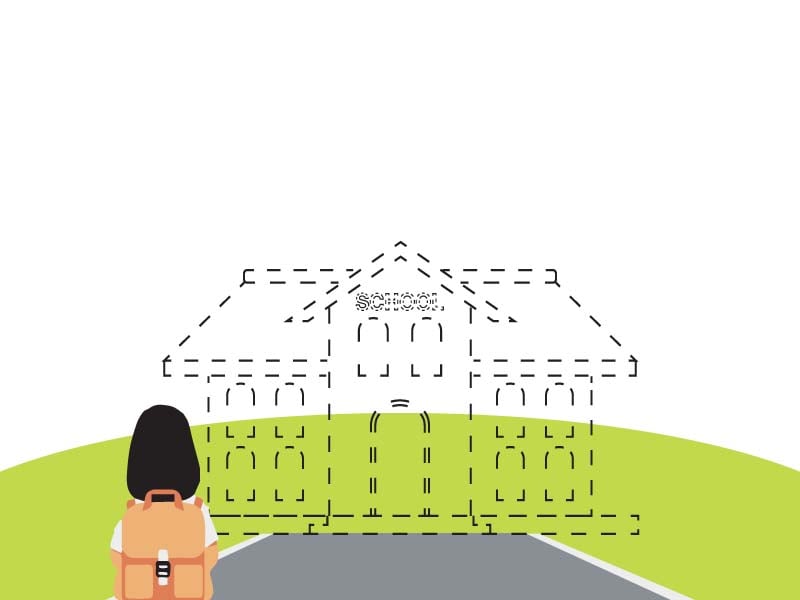
According to sources, the government constructed 23 girls’ schools in the area but for the past 15 years, the buildings have remained empty and abandoned. As a result, hundreds of girls like Razia have been deprived of education.
An educational emergency
In total, there are only 278 girls’ schools in Kohistan District, whereas the overall population of the district is 150,000. Statistics show that there is only one high school for girls in the area, but neither any higher-secondary schools nor a degree college.
Hafeez-ur-Rehman, the regional campaign organiser of Alif Ailaan – a nonprofit organisation working to alleviate Pakistan’s educational problems – told The Express Tribune that natural disasters, like the devastating earthquake of 2005 and the 2010 floods, destroyed the existing schools in Tehsil Kandia, after which the ruins of the buildings were never renovated.
“Owing to the absence of schools in the district, the literacy rate among women is hardly two percent,” Rehman said. “It is a big setback for the province, as well as for Pakistan.”
Disturbing numbers
According to the official data acquired from the Education Monitoring Information System, in 2013-14, only 21 girls were admitted to matric in the district. Overall, 18,241 female students had been admitted to government primary schools in Kohistan, while the literacy rate among male students has been much better as compared to girls. Collectively, 33, 408 male students took admission in government schools – from kindergarten to the fifth standard – and started their studies.
The information obtained through the Right to Information Act revealed that there is currently only one high school for girls in Kohistan District, in which 123 students are studying. There are six model schools in the district, wherein 56 girls are enrolled at present. Similarly, around 100 primary schools are educating 4,688 female students, whereas a total of 487 girls are enrolled in 107 primary and high girls’ schools across Kohistan.
To top it off, the records obtained from Kohistan’s government schools, out of the 606 posts for teachers, 162 have been lying vacant for the past five years, including 98 posts for primary school headteacher (PSHTs), 32 for senior primary school teacher (SPSTs) and 28 primary school teachers (PSTs).
Sheraz Ahmed said that they had informed CM’s Adviser on Elementary & Secondary Education Zia Ullah Bangash that 33 schools have been closed in Kohistan and hope that the government will do something about it soon,
Speaking about the worsening female literacy rate in the district, Education officer Kohistan Raja Sheraz Ahmed Kandial said that the closed schools were established in the past for political motives. District educational officers revealed that although data suggested thousands of girls were being admitted into schools every year, the reality on the ground was far from it.
What keeps women from education?
Sujmal Jadoon, a student from district Kohistan who acquired his master’s degree from Peshawar University, told The Express Tribune, that there are three reasons for the deplorable state of women’s education in the district.
The first reason, he reveals, is the net of regional customs and traditions which entrap women within the four walls of their house. For instance, in the case of early marriages in the district, girls tend to be taken out of school and married off while they’re still in 4th or 5th grade, which keeps them from pursuing middle and high-school education.
The second big reason as per Jadoon is the distance of schools from places of residence. When schools are located far from homes, women are usually not allowed to go to school by themselves. In the case of Kohistan, most schools tend to be far from residential areas, which inadvertently obstructs women’s access to education in the area
The third most prominent reason for the failing state of women’s education in Kohistan is the gross negligence of the government and political leaders.
“You’ll be surprised to know that Mohammad Dedar, a PTI member of Provincial Assembly, from Upper Kohistan is an only middle-school pass. Whereas, another PTI MPA from Lower Kohistan has only but a Madarsa degree,” he added.
What the future holds
Abdul Ghaffar, an MPA from Lower Kohistan told The Express Tribune that 90% of girls’ schools had to be closed down in the area owing to the lack of boundary walls and the deplorable conditions of the school buildings.
He further added that chief minister of K-P had been notified about the conditions and that they were in favor of sending their girls to school if schools were to be re-built and teachers were to be appointed.
Bangash told The Express Tribune that the provincial government plans to allocate Rs166 billion in the next budget for primary and secondary education for increasing literacy rate and reforms, in which 70% of the development budget will be reserved for girls and 30% for boys’ education.
Published in The Express Tribune, October 11th, 2019.

1732274008-0/Ariana-Grande-and-Kristin-Chenoweth-(1)1732274008-0-165x106.webp)





1732270499-0/Express-Tribune-(7)1732270499-0-270x192.webp)
1732267715-0/BeFunk_§_]__-(32)1732267715-0.jpg)

1732263788-0/BeFunk_§_]__-(30)1732263788-0.jpg)






COMMENTS
Comments are moderated and generally will be posted if they are on-topic and not abusive.
For more information, please see our Comments FAQ